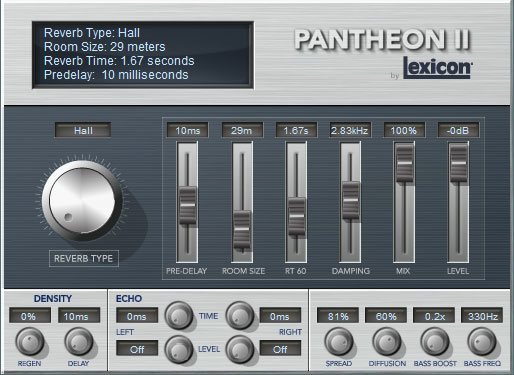

LEXICON REVERB PLUGIN DOWNLOAD MANUAL
The manual gives excellent descriptions of all the parameters and how they change the sound of the reverb. For any one who has ever used the LARC remote to control either a Lexicon 480L and 960L reverb, Lexicon PCM Native is an immediate "install and use" reverb-for the most part-no manual reading required.įor those new to reverb tweaking will find the most important, salient parameters immediately available and easily adjustable. Yet the interface's look, feel and operation remain consistent across all seven plug-ins. The seven reverbs are categorized as: Chamber, Concert Hall, Hall, Plate, Random Hall, Room, and Vintage Plate.īecause each reverb plug-in has a dedicated "engine", each comes with its own set of relevant parameters that are fully adjustable within the intuitive GUI. Ported in VST, AU and RTAS Native formats for both MACs and PCs, this bundle consists of seven plug-ins each using its own specialized reverb algorithm. Programming is now more precise due to the vast collection of algorithmic specific parameters and the three-dimensional RTA (real-time analyzer) color display that allows the visualization of the reverb's shape, character and evolution over time. This plug-in offers great, usable factory preset reverb sounds and, at the same time, "deep as you want" intense programmability for modifying or designing your own unique reverberant treatments. For example, you can try using three different delays with three different delay lengths and pan them to the right, the center, and the left.įurthermore, the delay calculator is very useful if you use guitar pedals, that allow you to enter a delay in milliseconds.Lexicon's PCM Native Reverb plug-in bundle is the company's long-awaited entry into a software-based reverb. It even gets more interesting if you use triplets or dotted notes. For depth, just try out different delay times out of the normal notes list.Ī great way to create movement is by adding multiple delays, with different timings.
The delay calculator helps you to find the right settings for your delay.

While most modern delay effects can be synchronized to the projects BPM some are not capable of doing this. The Delay and Reverb Time Calculator can help you with both. For example, when you want to add movement. But sometimes you also want the delay to be noticeable. Timing the delay to the tempo of your track will create depth while the delay is not noticeable. You can use a delay to make your tracks more interesting by adding movement, and also depth.
LEXICON REVERB PLUGIN DOWNLOAD HOW TO
You can find more information on how to mix reverb in this blog article by iZotope.ĭelay Calculator to determine the right delay time for your song You can also put a compressor on your reverb send and sidechain it to the audio source so the reverb gets ducked when your instrument plays. To further clean up your mix try a low- (600Hz) and a high cut (ca600Hz) on your reverb. If your snare hits on the 3rd beat, you can try out the whole notes delay time as a total reverb time. While the snare most often comes on upbeats the half note delay is always a good starting point if you are in a 4/4 time signature, and your snare hits on the 2nd, and 4th beat. The goal is that the reverb of one snare hit dies just before the next snare hit. Some additional tips: Often a room reverb for a song is adjusted to the snare.

If this is the case, you can use the same room reverb on all instruments to create the feeling that all instruments are playing in the same place. Especially if you only have instruments that would normally play in the same room. But use this technique cautiously, as many reverbs can also destroy your mix. Strings, for example, can sound amazing with a long reverb tail while the kick drum maybe should stay up front (it all depends on what you want to create). You can use different reverb settings for different instruments in your track to create depth. Using multiple reverbs to create depth in your track


 0 kommentar(er)
0 kommentar(er)
